From March 1 to March 6, the Dickinson-in-Bremen program traveled yet again to beautiful Vienna. The current group of students all wrote about their respective favorite activity. In Part I, read about the Austrian National Library, Modern Art in Vienna, The Hundertwasser Haus, and a theater performance we saw during the excursion.
The Austrian National Library
by Rachel Schilling
My favorite activity in Vienna, the one where I never stopped bouncing up and down and smiling during the course of it, was visiting the Austrian National Library. On the morning of the third of March the group headed over together to the Hofburg, the palatial complex that was the residence of the Austrian monarchy. While the entirety of Hofburg was beautiful, the library and its connected mu seums were heaven for a bibliophile like me. We started with a tour in the Prunksaal, the court library founded by Emperor Charles VI that was finished in the 1730s. The Prunksaal contains books from the very beginning of printing in the 1500’s. The library itself was beautiful with grand book shelves and beautiful ceiling frescos. We were shown some old books on flowers and allowed to smell them (for those that love the scent of old books as I do) and were told that we would be allowed , after buying a day library card, to have one of the books pulled from the shelves for us. I especially loved seeing the amazing hidden doorways that the workers use to shelve books and hearing about the current digitizing of the collection.
seums were heaven for a bibliophile like me. We started with a tour in the Prunksaal, the court library founded by Emperor Charles VI that was finished in the 1730s. The Prunksaal contains books from the very beginning of printing in the 1500’s. The library itself was beautiful with grand book shelves and beautiful ceiling frescos. We were shown some old books on flowers and allowed to smell them (for those that love the scent of old books as I do) and were told that we would be allowed , after buying a day library card, to have one of the books pulled from the shelves for us. I especially loved seeing the amazing hidden doorways that the workers use to shelve books and hearing about the current digitizing of the collection.
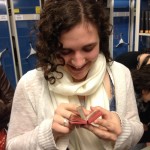
Rachel reading
We also got the chance to see some of the library’s archived books including some enchanting pop up books and miniature books which I was absolutely obsessed with. We looked at old lesson books which included an alphabet with three different types of S’s. We peeked into the very active current national library and saw the lift system that they use to transport books from the archive to areas where the public can use them.
Later that week, Ezra and I returned to Hofburg to also visit the museums that are a part of the larger library system, namely the Globe Museum and the Esperanto Museum, both extremely unique and interesting museums. The highlight of the Esperanto Museum was the modified Pac Man game that helped us learn a little Esperanto, the language that people once hoped would bring the entire world together under one language. The Globe Museum was fascinating. We were able  to catch a glimpse at how people perceived and misperceived the world (including a few maps where California was an island completely detached from the US). The entirety of the Vienna excursion was beautiful and fun, but getting to see the collections of the National Library was the biggest treat for someone that studies literature.
to catch a glimpse at how people perceived and misperceived the world (including a few maps where California was an island completely detached from the US). The entirety of the Vienna excursion was beautiful and fun, but getting to see the collections of the National Library was the biggest treat for someone that studies literature.
Modern Art in Vienna
by Adrienne Brown
Vienna, Austria is quite the destination for art enthusiasts. There were more art museums than I could visit in a week, and that is before one even starts to consider the special galleries and smaller art exhibitions. As a part of our Dickinson planned excursion in Vienna we had the opportunity to explore the Kunsthistorisches Museum (Art History Museum) and the Upper Belvedere art museum. Which, between the two of them, showcased some big-name artists like Rubens, Durer, Klimt, and Matisse, among others.
MuseumsQuartier

image source: Nicole Spies – Flicker
While I enjoy all kinds of art, the month I spent living in Berlin turned me into a lover of all things modern and contemporary. So I decided to branch out a bit and visit the MuseumsQuartier in my free time. MuseumsQuartier is located right in the heart of Vienna’s center city and it is far more than a museum. According to Google, MuseumsQuartier is the 8th largest cultural center in the world. It consists of four museums, an institute for modern/ contemporary dance, and a few bars. I had the opportunity to visit two of the art museums at MuseumsQuartier, the Kunsthalle Wien (Art Hall Vienna) and MUMOK. The other museums were, unfortunately, closed the day I went to visit.
Kunsthalle Wien – The Future of Memory
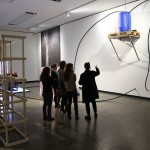
©: Lorenz Seidler – Flicker
The exhibition “The Future of Memory” is a good example of a challenging art exhibit. Some of the installations made me uncomfortable, others forced me to think critically about memory, identity, and technology. The mediums exhibited varied widely. As one entered the space there were sixty watches laid out on the ground in a perfect circle. I learned the hard way that one must pay more attention to the floor in art museums these days. In one corner a baby swing propelled itself back and forth in a never ending rhythm that was more than a little disconcerting. In another corner an empty projector flipped through the slots where the slides should have been. I stood in front of the empty projector for a good while wondering if any sort of image would eventually pop up, and then it dawned on me that the projector was in fact empty. On the back wall of the exhibition films about the connection between memory and identity played over and over.
One of these films was a short documentary about how countries in south-east Europe, such as Croatia, are currently struggling with a disconnect between identity and memory. Due to their recent history, they are disillusioned with their current identity and are trying to create a new one. However, there is a general feeling that they lack the role models necessary to build a new identity. There has been some debate among artists, but currently numerous statutes are being built in tribute to foreign role models such as: Bill Clinton, Rocky and Bruce Lee. Other artists, however, are trying to remain honest and deal with the identity crisis by taking it on rather than running from it.
As one might understand, I needed some time to processes what I had just seen in the Kunsthalle Wien, so I decided to get a coffee and a cupcake in the cupcake cafe. Which may be a shameless plug, but I don’t think any art-complex is complete without a cupcake cafe. Once I digested everything, I was off to go take in some more art. This time at the MUMOK museum, which was featuring the exhibit “Ludwig goes POP!”
“Ludwig goes Pop!”
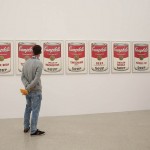
Santiago
featured some really big names in pop art. Roy Lichtenstein and Andy Warhol mostly, but also a few cool artists that my art professor is obsessed with. The most striking part of this exhibit was just to see those artists we are always hearing about in real life. I mean I’ve seen so many pictures of Warhol’s “Campbell’s Soup”, but seeing a print in real life is kind of magical. It’s also weird to see the little name plate next to Warhol’s name that reads “Pittsburgh, Pennsylvania” and think I came all the way to Vienna, Austria from Carlisle, Pennsylvania and here is art from a Pennsylvania artist… All in all, Vienna was wonderful and I want to go back to visit the other two museums at MuseumsQuartier, among others.
The Hundertwasser Haus
by Katherine Mooradian
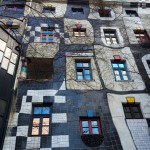 My favorite part of the Vienna Excursion was easily the Hundertwasserhaus and Museum. I had seen pictures of his architecture in previous German classes at Dickinson but I never knew that he was also an artist. Not only that but he was a true visionary. I found the experience very inspiring. He has designed four buildings in Vienna, three of which I saw on site, the Hundertwasserhaus, Hundertwasser village, and the KunsthausWien. His last building in Vienna is a heating plant. In his architecture he strives to create a harmony with nature which I found intriguing. All of his houses were filled with plants, a major part of his design was always green roofs, covered in grass or trees. He advocated for more beautiful building styles rejecting stark horizontal and vertical lines, which almost
My favorite part of the Vienna Excursion was easily the Hundertwasserhaus and Museum. I had seen pictures of his architecture in previous German classes at Dickinson but I never knew that he was also an artist. Not only that but he was a true visionary. I found the experience very inspiring. He has designed four buildings in Vienna, three of which I saw on site, the Hundertwasserhaus, Hundertwasser village, and the KunsthausWien. His last building in Vienna is a heating plant. In his architecture he strives to create a harmony with nature which I found intriguing. All of his houses were filled with plants, a major part of his design was always green roofs, covered in grass or trees. He advocated for more beautiful building styles rejecting stark horizontal and vertical lines, which almost  exclusively is found in man made creations. My favorite part of the museum was the uneven flooring. This technique is found in the majority of Hundertwasser’s architecture. Throughout the museum there were quotes and writings by Hundertwasser which added congruence to his life work on display.
exclusively is found in man made creations. My favorite part of the museum was the uneven flooring. This technique is found in the majority of Hundertwasser’s architecture. Throughout the museum there were quotes and writings by Hundertwasser which added congruence to his life work on display.
 The artist himself has an extremely interesting history and personality. He is known for being an environmental activist and opposed the EU. He advocated for strong individualism and a reconciliation of humans with nature.
The artist himself has an extremely interesting history and personality. He is known for being an environmental activist and opposed the EU. He advocated for strong individualism and a reconciliation of humans with nature.
“It is disgusting to see what is understood as freedom now. When you stroll through the city you get the feeling that you are walking through a prison: ruler-edged windows, ruler-edged buildings, the people as identical as if they wore prison uniforms. It is a self-made prison. What the people now take to mean freedom is no longer a jail which they are forced into but rather one which they themselves obediently enter. For they have already learned the taboos and prohibitions by heart.” – Real Freedom, 1966
Hundertwasser’s art spoke to me for this reason. He was not afraid to break the rules. He lived for himself, and in realizing his vision he created, and designed practical solutions to real world problems, such as sustainable living communities with his classic green roofs. Furthermore by being free to really express himself, and actualize his dreams he inspires others to do the same.
“Art exists only in an enslaved society like ours. In a free society “art” exists neither as an undersupplied commodity nor as spiritual edification. Art is as omnipresent and natural as the grass and trees, which grows wherever there is water. The attainment of this goal is the artist’s holy commitment. He alone possesses a sure instinct for the coming disaster. And so he simply cannot keep still as he watches the society in which he lives, sink into subjugation.” – Real Freedom, 1966
“Freunde, das Leben ist lebenswert!”
by Madison Alley
Vienna is rich with history. I thoroughly enjoyed our tours through various Habsburg estates, resting places, museums, and treasuries, but the most impacting experience I had during our time there was at a small theater directly next to our hotel. The play we saw is entitled “Freunde, das Leben ist lebenswert!” (Friends, Life is Worth Living!). It follows the lives of a Jewish  doctor and poet, Fritz Löhner, and his two Jewish friends, as well as his non-Jewish driver, beginning at the rise of Hitler and ending, as so many lives did, with their respective deaths in a concentration camp. The driver in the story, Prohaska, is an aspiring poet, but lacks the skill that Löhner has with words. Later, Prohaska joins Hitler’s force as a Nazi and becomes famous by forcing Löhner and his friends to write songs for which he takes credit. If I had to describe the play with only one word, it would have to be “shocking”. The brutality with which Jews were treated during this time period is not a surprise; however, seeing these intense situations acted out – in Austria, and in German – left me breathless by the end of the performance. I was constantly surprised throughout the play, taken aback by the bluntness and the very straightforward and heartbreakingly honest way these incredibly sensitive scenes were portrayed.
doctor and poet, Fritz Löhner, and his two Jewish friends, as well as his non-Jewish driver, beginning at the rise of Hitler and ending, as so many lives did, with their respective deaths in a concentration camp. The driver in the story, Prohaska, is an aspiring poet, but lacks the skill that Löhner has with words. Later, Prohaska joins Hitler’s force as a Nazi and becomes famous by forcing Löhner and his friends to write songs for which he takes credit. If I had to describe the play with only one word, it would have to be “shocking”. The brutality with which Jews were treated during this time period is not a surprise; however, seeing these intense situations acted out – in Austria, and in German – left me breathless by the end of the performance. I was constantly surprised throughout the play, taken aback by the bluntness and the very straightforward and heartbreakingly honest way these incredibly sensitive scenes were portrayed.
For whatever reason I was simply not expecting such a dynamic and dramatic representation of the events captured in this play. It was, literally, breathtaking.
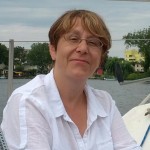
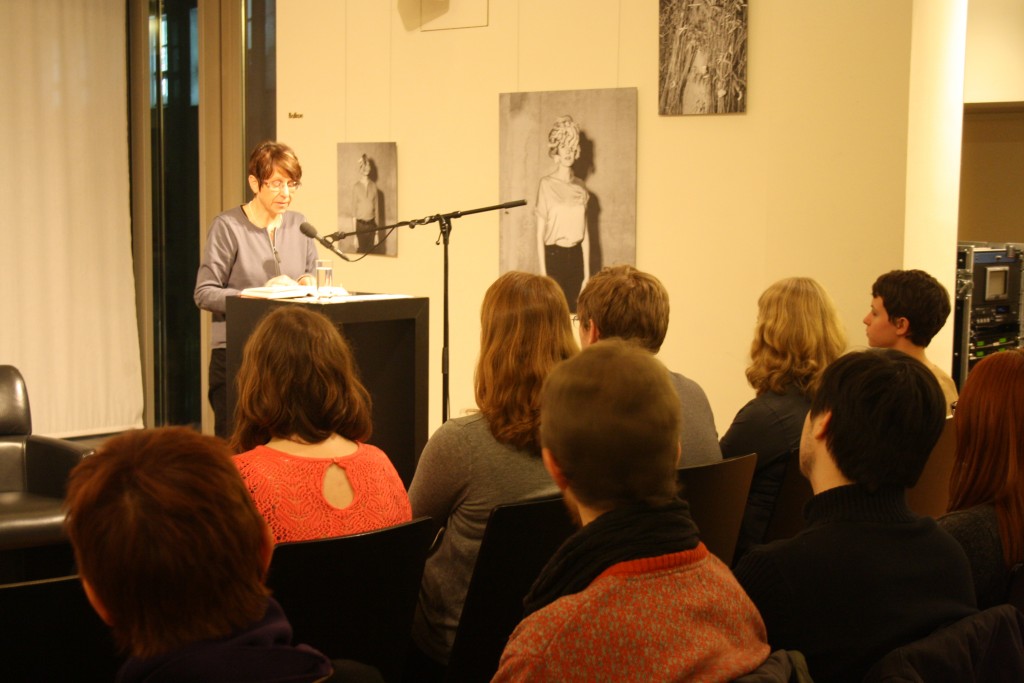


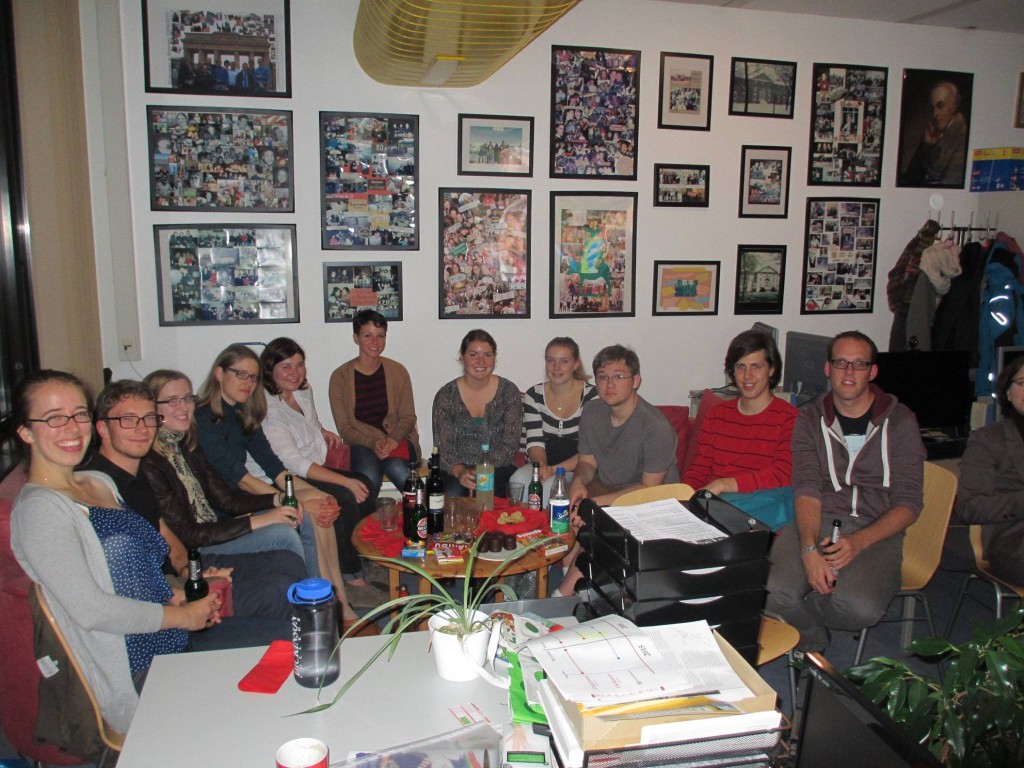
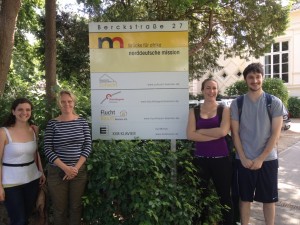
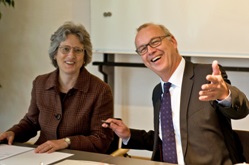

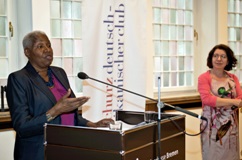
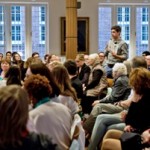
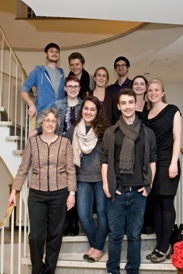
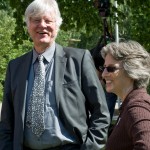

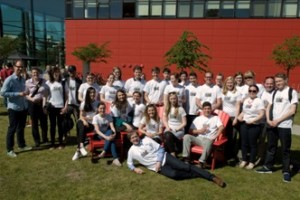
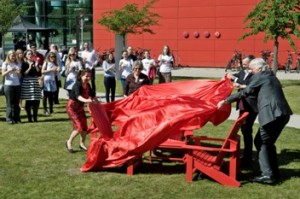
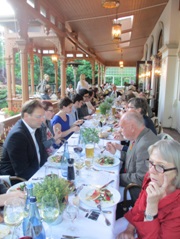
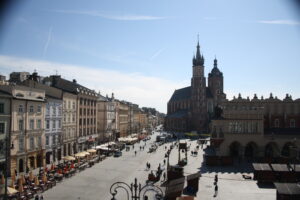
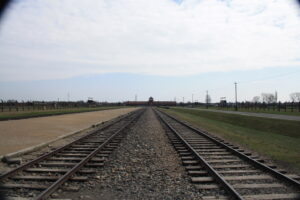

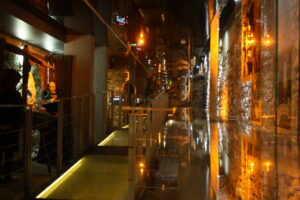
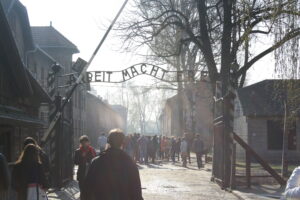

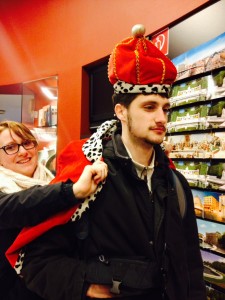
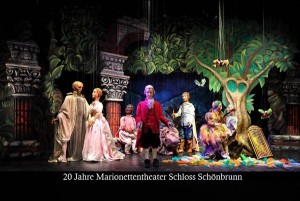
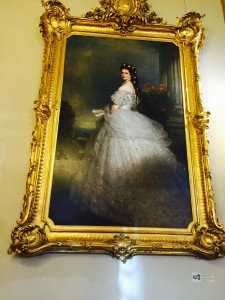
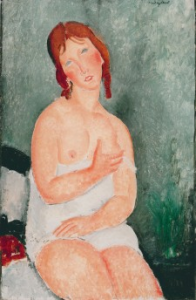










![image[8]](http://blogs.dickinson.edu/bremen/files/2016/03/image8-225x300.jpeg)
![image[1]](http://blogs.dickinson.edu/bremen/files/2016/03/image1-300x225.jpeg) For the first three weeks of the internship Madison and I worked together on the composition of IHMG’s first newsletter of the year and then completed a multitude of translations including the newsletter, biographies of the members of IHMG and the descriptions of the past Müller Monday events, an event that IHMG hosts each month in cooperation with the Literaturforum at the Brechthaus. As we completed these translations we got a better idea of both the work that IHMG does and the members of the society. Finally, at the end of the month, we put this information to use when we traveled to Berlin for a week to work alongside the Chief Executive of the IHMG, Anja Quickert. For this week we worked on more translations, assisted with the preparation and running of February’s Müller Monday panel discussion, and discovered the city of Berlin as we handed out hundreds of flyers about IHMG’s events and the society in general.
For the first three weeks of the internship Madison and I worked together on the composition of IHMG’s first newsletter of the year and then completed a multitude of translations including the newsletter, biographies of the members of IHMG and the descriptions of the past Müller Monday events, an event that IHMG hosts each month in cooperation with the Literaturforum at the Brechthaus. As we completed these translations we got a better idea of both the work that IHMG does and the members of the society. Finally, at the end of the month, we put this information to use when we traveled to Berlin for a week to work alongside the Chief Executive of the IHMG, Anja Quickert. For this week we worked on more translations, assisted with the preparation and running of February’s Müller Monday panel discussion, and discovered the city of Berlin as we handed out hundreds of flyers about IHMG’s events and the society in general.![image[2]](http://blogs.dickinson.edu/bremen/files/2016/03/image2-150x150.jpeg) This internship was great for me simply because it helped improve both my knowledge of German and even English through the work with translation. Working with IHMG was, however, most rewarding, because of the opportunity it gave me to work closely with the head of a non-profit organization. After Dickinson I hope to go into the non-profit sector and work to advance literacy around the world. So the short introduction I got in the inner workings of IHMG as well as receiving practice both networking for the society and thanking the donors are invaluable moments for me. I look forward to taking my experience at IHMG and applying it to my work post Dickinson. >Rachel Schilling<
This internship was great for me simply because it helped improve both my knowledge of German and even English through the work with translation. Working with IHMG was, however, most rewarding, because of the opportunity it gave me to work closely with the head of a non-profit organization. After Dickinson I hope to go into the non-profit sector and work to advance literacy around the world. So the short introduction I got in the inner workings of IHMG as well as receiving practice both networking for the society and thanking the donors are invaluable moments for me. I look forward to taking my experience at IHMG and applying it to my work post Dickinson. >Rachel Schilling<